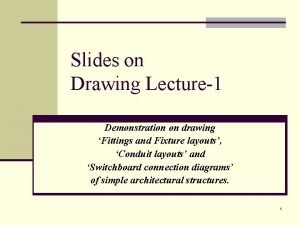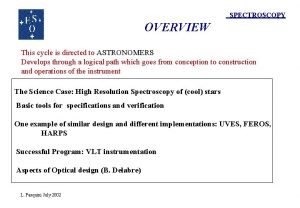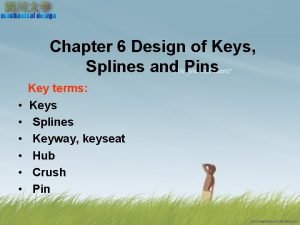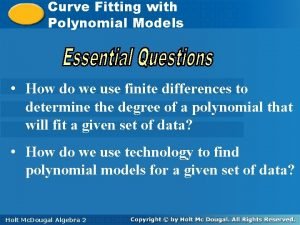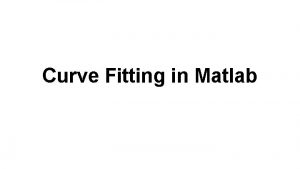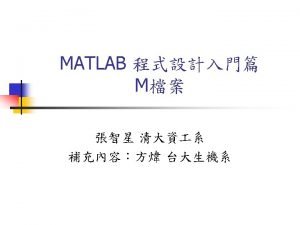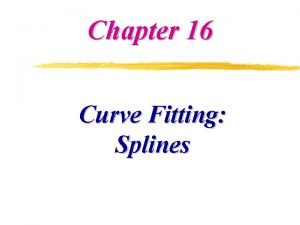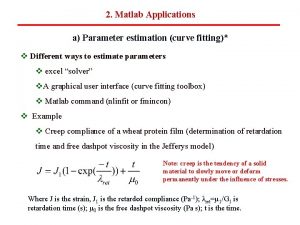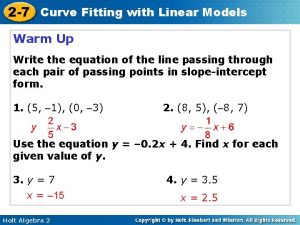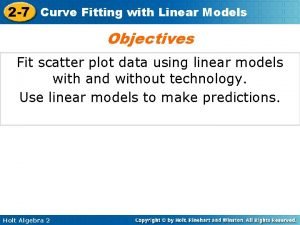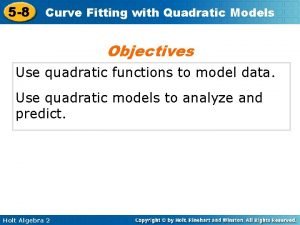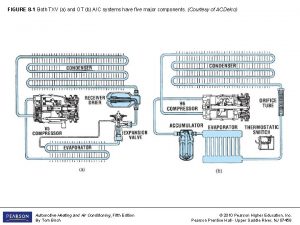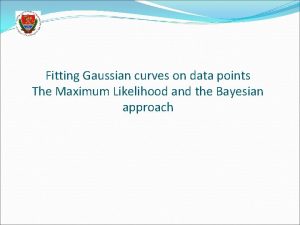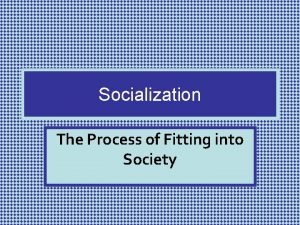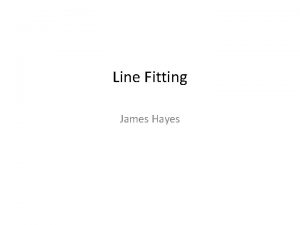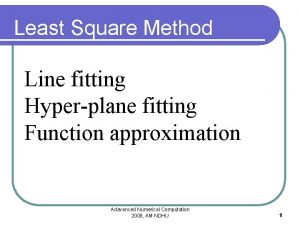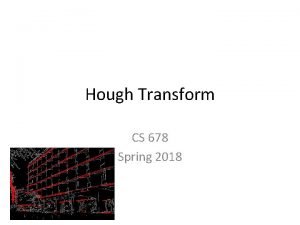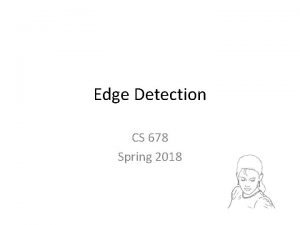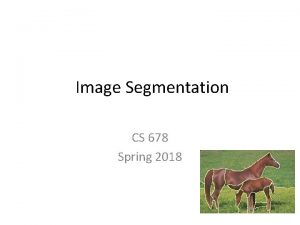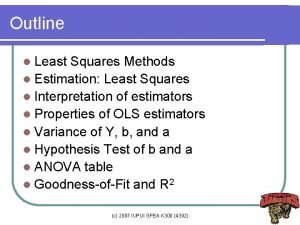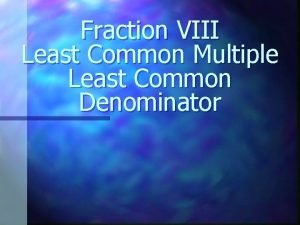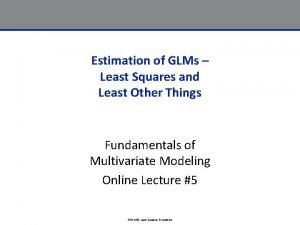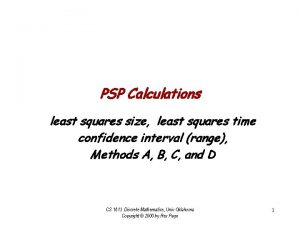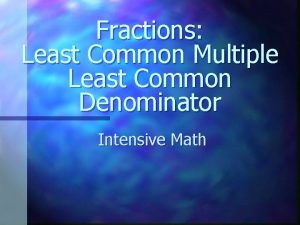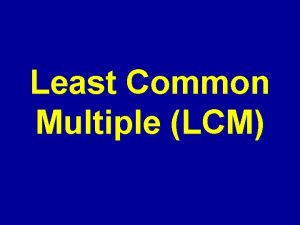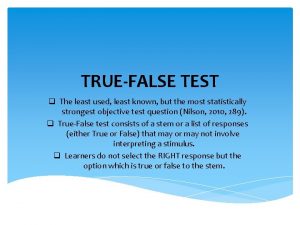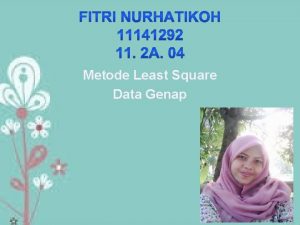Fitting CS 678 Spring 2018 Outline Fitting Least


























- Slides: 26

Fitting CS 678 Spring 2018

Outline • Fitting – Least square estimation – Robust estimation – RANSAC • Reading: FP 3. 1 & 15 Szeliski’s book 6. 1 Some slides from Lazebnik

Fitting: Motivation • We’ve learned how to detect edges, corners, SIFT, etc. Now what? • We would like to form a higher-level, more compact representation of the features in the image by grouping multiple features according to a simple model 9300 Harris Corners Pkwy, Charlotte, NC

Fitting • Choose a parametric model to represent a set of features simple model: lines simple model: circles complicated model: car Source: K. Grauman

Fitting • Choose a parametric model to represent a set of features • Membership criterion is not local – Can’t tell whether a point belongs to a given model just by looking at that point • Three main questions: – What model represents this set of features best? – Which of several model instances gets which feature? – How many model instances are there? • Computational complexity is important – It is infeasible to examine every possible set of parameters and every possible combination of features

Fitting: Issues Case study: Line detection • Noise in the measured feature locations • Extraneous data: clutter (outliers), multiple lines • Missing data: occlusions

Fitting: Issues • If we know which points belong to the line, how do we find the “optimal” line parameters? – Least squares • What if there are outliers? – Robust fitting, RANSAC • What if there are many lines? – Voting methods: RANSAC, Hough transform • What if we’re not even sure it’s a line? – Model selection

Least squares line fitting • Data: (x 1, y 1), …, (xn, yn) • Line equation: yi = m xi + b • Find (m, b) to minimize y=mx+b (xi, yi)

Least squares line fitting • Data: (x 1, y 1), …, (xn, yn) • Line equation: yi = m xi + b • Find (m, b) to minimize y=mx+b (xi, yi) Normal equations: least squares solution to XB=Y

Problem with “vertical” least squares • Not rotation-invariant • Fails completely for vertical lines

Total least squares • Distance between point (xn, yn) and line ax+by=d (a 2+b 2=1): |ax + by – d| • Find (a, b, d) to minimize the sum of squared perpendicular distances ax+by=d (xi, yi) Unit normal: N=(a, b)

Total least squares • Distance between point (xn, yn) and line ax+by=d (a 2+b 2=1): |ax + by – d| • Find (a, b, d) to minimize the sum of squared perpendicular distances ax+by=d (xi, yi) Unit normal: N=(a, b) Solution to (UTU)N = 0, subject to ||N||2 = 1: eigenvector of UTU associated with the smallest eigenvalue (least squares solution to homogeneous linear system UN = 0)

Total least squares second moment matrix

Total least squares second moment matrix N = (a, b)

Least squares as likelihood maximization • Generative model: line points are corrupted by Gaussian noise in the direction perpendicular to the line point on the line noise: zero-mean Gaussian with std. dev. σ normal direction ax+by=d ε (u, v) (x, y)

Least squares as likelihood maximization • Generative model: line points are corrupted by Gaussian noise in the direction perpendicular to the line Likelihood of points given line parameters (a, b, d): Log-likelihood: ax+by=d ε (u, v) (x, y)

Least squares for general curves • We would like to minimize the sum of squared geometric distances between the data points and the curve (xi, yi) d((xi, yi), C) curve C

Least squares for conics • Equation of a general conic: C(a, x) = a · x = ax 2 + bxy + cy 2 + dx + ey + f = 0, a = [a, b, c, d, e, f], x = [x 2, xy, y 2, x, y, 1] • Minimizing the geometric distance is non-linear even for a conic • Algebraic distance: C(a, x) • Algebraic distance minimization by linear least squares:

Least squares for conics • Least squares system: Da = 0 • Need constraint on a to prevent trivial solution • Discriminant: b 2 – 4 ac – Negative: ellipse – Zero: parabola – Positive: hyperbola • Minimizing squared algebraic distance subject to constraints leads to a generalized eigenvalue problem – Many variations possible • For more information: – A. Fitzgibbon, M. Pilu, and R. Fisher, Direct least-squares fitting of ellipses, IEEE Transactions on Pattern Analysis and Machine Intelligence, 21(5), 476 --480, May 1999

Robust estimators • General approach: minimize ri (xi, θ) – residual of ith point w. r. t. model parameters θ ρ – robust function with scale parameter σ The robust function ρ behaves like squared distance for small values of the residual u but saturates for larger values of u

Robust estimation: Notes • Robust fitting is a nonlinear optimization problem that must be solved iteratively • Least squares solution can be used for initialization • Adaptive choice of scale: “magic number” times median residual

RANSAC • Robust fitting can deal with a few outliers – what if we have very many? • Random sample consensus (RANSAC): Very general framework for model fitting in the presence of outliers • Outline – Choose a small subset uniformly at random – Fit a model to that subset – Find all remaining points that are “close” to the model and reject the rest as outliers – Do this many times and choose the best model M. A. Fischler, R. C. Bolles. Random Sample Consensus: A Paradigm for Model Fitting with Applications to Image Analysis and Automated Cartography. Comm. of the ACM, Vol 24, pp 381 -395, 1981.

RANSAC for line fitting Repeat N times: Draw s points uniformly at random Fit line to these s points Find inliers to this line among the remaining points (i. e. , points whose distance from the line is less than t) • If there are d or more inliers, accept the line and refit using all inliers • •


Choosing the parameters • Initial number of points s – Typically minimum number needed to fit the model • Distance threshold t – Choose t so probability for inlier is p (e. g. 0. 95) – Zero-mean Gaussian noise with std. dev. σ: t 2=3. 84σ2 • Number of samples N – Choose N so that, with probability p, at least one random sample is free from outliers (e. g. p=0. 99) (outlier ratio: e) Source: M. Pollefeys

RANSAC pros and cons • Pros – Simple and general – Applicable to many different problems – Often works well in practice • Cons – Lots of parameters to tune – Can’t always get a good initialization of the model based on the minimum number of samples – Sometimes too many iterations are required – Can fail for extremely low inlier ratios – We can often do better than brute-force sampling
 Angela tramonte
Angela tramonte 665 vs 678
665 vs 678 Kingdom 678
Kingdom 678 678 error in bsnl broadband connection
678 error in bsnl broadband connection Spring season months
Spring season months Kim ki duk summer fall winter spring
Kim ki duk summer fall winter spring Que letra continua m v t m j
Que letra continua m v t m j Flavorful sentence
Flavorful sentence Conduit layout drawing
Conduit layout drawing Hyades
Hyades Taper key design
Taper key design Curve fitting with polynomial models
Curve fitting with polynomial models Curve fitting matlab
Curve fitting matlab Matlab sine fitting
Matlab sine fitting Spline fit matlab
Spline fit matlab Parameter estimation in matlab
Parameter estimation in matlab Pilkington planar maintenance
Pilkington planar maintenance Curve fitting with linear models
Curve fitting with linear models Curve fitting with linear models
Curve fitting with linear models Quadratic curve fitting
Quadratic curve fitting Exponential and logarithmic models
Exponential and logarithmic models Transformer fitting
Transformer fitting A/c fitting size chart
A/c fitting size chart Castan golf fitting
Castan golf fitting Gaussian curve fitting
Gaussian curve fitting Professional shoe fitting
Professional shoe fitting Fitting into society
Fitting into society








